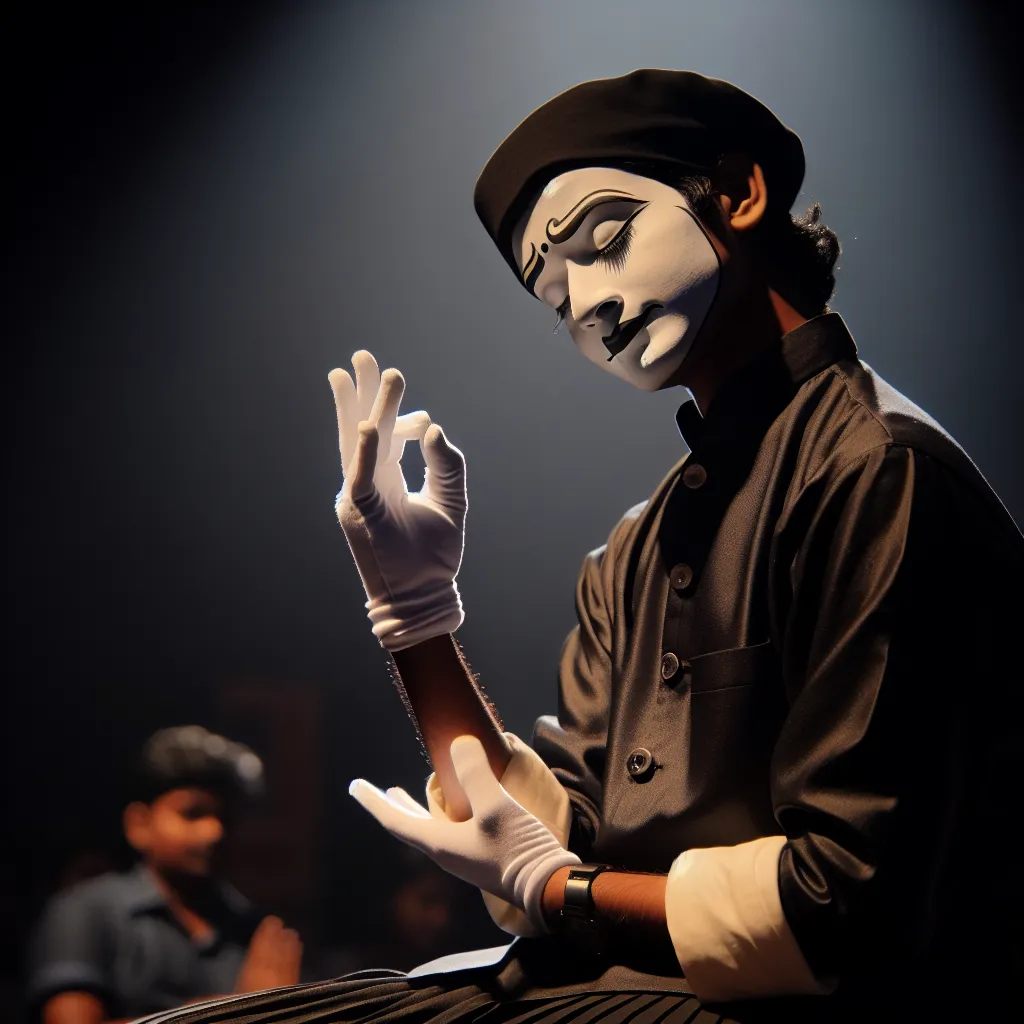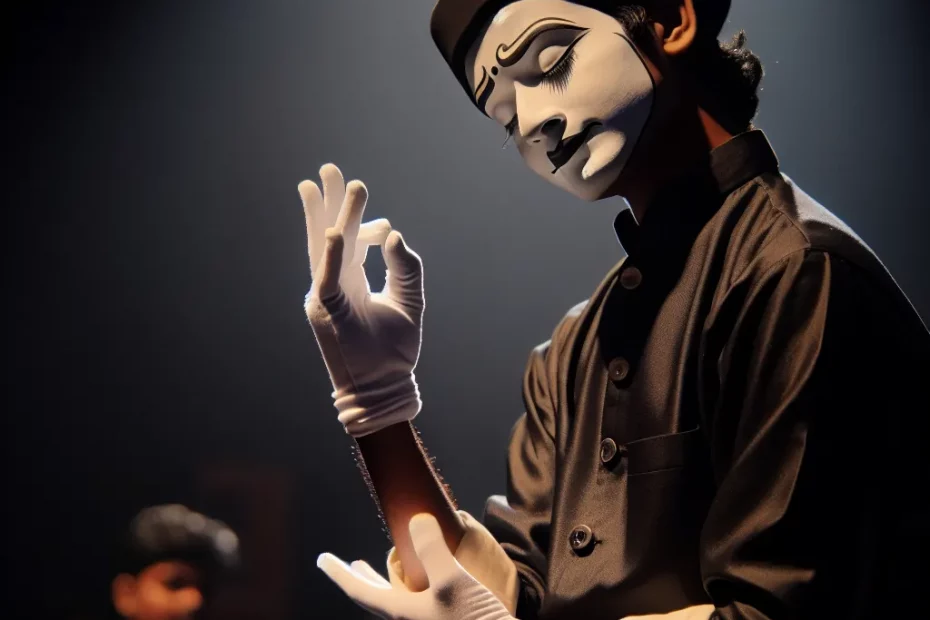As we delve into the captivating world of mime, we are transported to a realm where silence speaks volumes and gestures convey profound emotions. The art of mime, with its rich history and global impact, serves as a testament to the power of non-verbal communication. Through intricate techniques and dedicated training, mimes from around the world bring stories to life without uttering a single word. Join me on a journey to explore the enchanting realm of mime at the Chuncheon International Mime Festival, where artists showcase their unparalleled skills and creativity on a prestigious stage. Let us witness firsthand the magic and artistry that transcend language barriers and cultural differences, uniting us in a shared appreciation for the universal language of expression.

What is Mime?
Mime is a form of silent performance art that dates back centuries, originating from ancient Greece and Rome. It involves using gestures, facial expressions, and body movements to convey a story or message without the use of words. The art of mime requires a high level of physical control, expression, and creativity to effectively communicate with the audience.
The Use of Imaginary Objects and Environments
One of the key elements of mime is the use of imaginary objects and environments. Mimes create invisible walls, doors, and objects through their movements, allowing the audience to visualize the scene in their minds. This requires precise and exaggerated movements to make the invisible visible.
Incorporating Comedy, Drama, and Illusion
Mime artists often incorporate elements of comedy, drama, and illusion into their performances. They can evoke a wide range of emotions from laughter to tears, captivating audiences with their versatility and skill. Through intricate movements and expressions, mimes can tell complex stories and explore various themes without uttering a single word.
The Chuncheon International Mime Festival
The Chuncheon International Mime Festival is a celebration of this unique art form, bringing together talented mime artists from around the world to showcase their skills and creativity. It provides a platform for artists to exchange ideas, collaborate, and inspire each other, pushing the boundaries of what mime can achieve.
The Power of Mime as a Universal Language
Mime is not just entertainment; it is a powerful form of expression that transcends language barriers and cultural differences. It has the ability to communicate universal themes and emotions, touching the hearts of audiences regardless of their background. By witnessing the art of mime at festivals like Chuncheon International Mime Festival, audiences can experience the beauty and magic of this silent art form firsthand.
In conclusion, mime is a captivating art form that relies on the physicality and expressiveness of the performer to convey stories and emotions without words. It is a universal language that speaks to the soul, making audiences laugh, cry, and ponder the complexities of life through the power of silence and movement. The Chuncheon International Mime Festival is a testament to the enduring appeal and artistry of mime, showcasing the talents of artists from diverse backgrounds and cultures.
The History of Mime
In the realm of performing arts, Mime stands as a timeless and captivating form of expression that transcends language barriers. The art of Mime, with its origins dating back to ancient Greece, has evolved over centuries to become a sophisticated and nuanced art form that continues to enthrall audiences worldwide.
The Origins of Mime
Mime, derived from the Greek word “mimos,” meaning “imitator” or “actor,” has a rich history that spans cultures and civilizations. From the silent performances of ancient Greek actors to the elaborate pantomimes of the Italian Commedia dell’arte in the 16th century, Mime has always been a powerful means of storytelling without words.
The Revival of Mime
In the 19th century, the art of Mime experienced a revival with the emergence of famous performers such as Jean-Gaspard Deburau, who popularized the character of Pierrot in his silent performances at the Théâtre des Funambules in Paris. This era marked a significant shift in Mime as a form of entertainment that combined physicality, emotion, and storytelling in a unique and compelling way.
The Modern Era of Mime
The 20th century saw Mime gaining international recognition and acclaim, with artists like Marcel Marceau, often referred to as the “father of modern Mime,” revolutionizing the art form with his iconic character Bip the Clown. Marceau’s performances, characterized by his mastery of movement, expression, and illusion, brought Mime to new heights of artistic excellence and popularity.
The Contemporary Landscape of Mime
Today, Mime continues to thrive as a dynamic and diverse art form, with practitioners from around the world pushing the boundaries of traditional Mime techniques and exploring innovative ways to engage and inspire audiences. From classic silent performances to contemporary experimental works, Mime remains a vibrant and evolving art form that captivates audiences of all ages.
As we delve into the history of Mime, we uncover a rich tapestry of creativity, innovation, and cultural exchange that has shaped this unique art form into what it is today. From its humble beginnings in ancient Greece to its modern-day interpretations, Mime continues to enchant and mesmerize audiences with its timeless appeal and universal language of expression.
Mime Techniques and Training
Welcome to the fascinating world of mime techniques and training! In the realm of performing arts, mime stands out as a unique form of expression that relies heavily on body movements, gestures, and facial expressions to convey stories and emotions without the use of words. The art of mime requires a high level of precision, control, and creativity, making it a challenging yet rewarding discipline to master.
Mime Training
Mime artists undergo rigorous training to develop their skills and techniques. They focus on mastering various elements such as body posture, hand gestures, facial expressions, and movement dynamics to create compelling performances that captivate audiences worldwide. Through dedicated practice and rehearsal, mime artists refine their abilities to communicate complex narratives and emotions purely through physicality.
Body Awareness and Control
One key aspect of mime training is the emphasis on body awareness and control. Artists learn how to use their bodies as instruments of expression, honing their ability to convey subtle nuances and emotions through precise movements. By mastering techniques such as isolations, dynamics, and illusions, mime artists can create illusions of objects, environments, and characters with remarkable realism.
Pantomime Techniques
Another essential component of mime training is the study of pantomime, a form of silent performance that focuses on storytelling through exaggerated gestures and actions. Pantomime techniques help artists develop their narrative skills, allowing them to create vivid and engaging performances that resonate with audiences of all ages. By incorporating elements of humor, drama, and suspense, mime artists can craft compelling stories that transcend language barriers and cultural differences.
Creativity and Improvisation
In addition to technical skills, mime training also places a strong emphasis on creativity and improvisation. Artists are encouraged to explore new ideas, experiment with different styles, and push the boundaries of traditional mime techniques to create innovative and original performances. By fostering a spirit of creativity and exploration, mime training empowers artists to push their artistic boundaries and continuously evolve as performers.
Aspiring Mime Artists
Aspiring mime artists often seek out reputable training programs, workshops, and mentorship opportunities to enhance their skills and expand their artistic horizons. By immersing themselves in a supportive and collaborative learning environment, artists can gain valuable insights, feedback, and guidance from experienced professionals in the field. Through dedicated practice, perseverance, and a passion for the art of mime, aspiring artists can unlock their full potential and make a lasting impact in the world of performing arts.
In conclusion, mime techniques and training play a crucial role in shaping the skills, creativity, and artistry of mime artists around the world. By mastering the fundamentals of body movement, gesture, and expression, artists can create powerful performances that transcend language and cultural barriers, captivating audiences with their unique storytelling abilities. Whether you are a seasoned professional or an aspiring newcomer to the world of mime, the journey of training and self-discovery in mime artistry is a rewarding and transformative experience that continues to inspire and delight audiences worldwide.
The Global Impact of Mime
The art of mime, with its silent storytelling and expressive movements, has a profound impact on a global scale. From the streets of Paris to the theaters of Tokyo, mime artists captivate audiences and transcend language barriers with their performances. The Chuncheon International Mime Festival stands as a testament to the universal appeal of mime, bringing together artists from around the world to showcase their talent and creativity.
International Collaboration
The Chuncheon International Mime Festival serves as a melting pot of cultures, where mime artists from diverse backgrounds come together to exchange ideas and techniques. This cross-cultural collaboration not only enriches the art form but also fosters understanding and unity among nations.
Cultural Exchange
Through mime, artists communicate universal themes and emotions that resonate with audiences worldwide. Whether it’s a comedic sketch or a poignant piece, mime transcends cultural boundaries and speaks to the shared human experience.
Artistic Innovation
The festival provides a platform for mime artists to push the boundaries of the art form and experiment with new styles and techniques. From classic pantomime to contemporary physical theater, the performances at the Chuncheon International Mime Festival showcase the evolution and innovation of mime as an art form.
Inspiring the Next Generation
By exposing audiences to the beauty and complexity of mime, the festival inspires a new generation of artists and performers. Through workshops, masterclasses, and outreach programs, the festival cultivates a passion for mime in young aspiring artists, ensuring the art form’s legacy for years to come.
Celebrating Diversity
The Chuncheon International Mime Festival celebrates diversity and inclusivity, welcoming artists of all backgrounds and abilities to participate. By showcasing a wide range of styles and perspectives, the festival highlights the richness and variety of the global mime community.
In conclusion, the Chuncheon International Mime Festival serves as a beacon of creativity, collaboration, and cultural exchange on the global stage. Through the art of mime, artists from around the world come together to inspire, entertain, and unite audiences, leaving a lasting impact that transcends borders and languages.
🌏🎭
As we delve into the fascinating world of mime through the Chuncheon International Mime Festival, we are reminded of the universal language that transcends barriers. From the rich history and diverse techniques to the global impact it has made, mime continues to captivate audiences worldwide. Witnessing the artistry and skill of mime performers from different corners of the globe not only entertains but also educates, offering a unique perspective on storytelling without words. The festival serves as a testament to the power of non-verbal communication and the creativity that knows no bounds. Through mime, we are reminded of the beauty of simplicity and the profound impact of a gesture or expression. In a world filled with noise, mime stands out as a powerful reminder of the beauty of silence and the art of expression.
